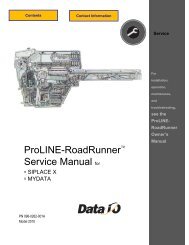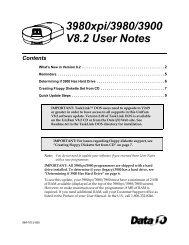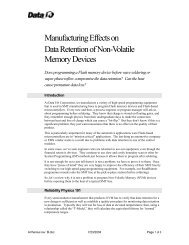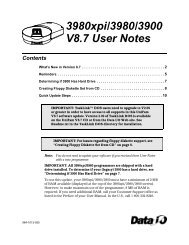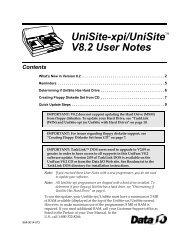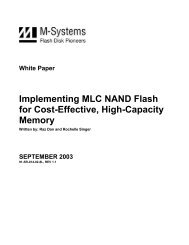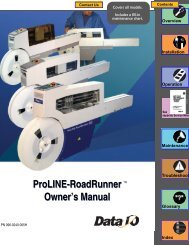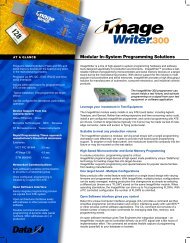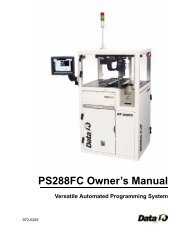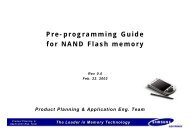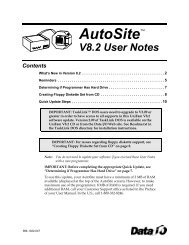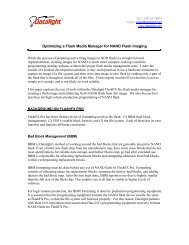3980xpi Users Manual - Data I/O Corporation
3980xpi Users Manual - Data I/O Corporation
3980xpi Users Manual - Data I/O Corporation
Create successful ePaper yourself
Turn your PDF publications into a flip-book with our unique Google optimized e-Paper software.
Edit Memory Menu<br />
Commands<br />
The Edit Memory menu appears if you have selected a memory device. This<br />
menu contains the Edit Memory, Complement, <strong>Data</strong> Copy, Fill Memory, and<br />
Swap Memory commands.<br />
Edit Memory<br />
More Commands/Edit <strong>Data</strong>/Edit Memory/Edit Memory <strong>Data</strong><br />
Use the Edit Memory command to edit the data for a memory device. To edit<br />
data stored in memory, follow these steps:<br />
1. Specify the memory editing parameters.<br />
2. Press ENTER to enter the editor. Depending on the selected word width, the<br />
4-, 8-, or 16-bit word width memory editor screen appears.<br />
3. To change data, move the cursor to the memory location to be changed<br />
and type the new characters over the old ones. Enter the data either in hex<br />
or ASCII mode (select the mode using TAB as described below). The<br />
cursor’s location is shown as a hex address at the top of the screen.<br />
The parameters and editor commands are described below.<br />
� Source (R,D)<br />
Specifies the source of the data to be edited. Press SPACE to toggle<br />
between R (RAM) and D (Disk).<br />
� Filename<br />
Specifies the name of the disk file containing the data to edit. This option<br />
appears only if you select disk as the Source. The filename must follow<br />
standard DOS conventions. An example of a valid filename is 27c256.dat.<br />
The file must be an absolute binary file.<br />
� Edit <strong>Data</strong> Word Width (4,8,16,32)<br />
Selects a 4-, 8-, 16-, or 32-bit <strong>Data</strong> Word Width. Press SPACE to toggle<br />
between the 4-, 8-, and 16-bit options. If you select 8, the editor treats all<br />
addresses as byte addresses. If you select 16 or 32, the editor treats all<br />
addresses as 16- or 32-bit word addresses and the Edit Odd/Even Byte<br />
Swap feature is enabled.<br />
� Edit Address Offset<br />
Specifies the address you want assigned to the first byte of data in user<br />
memory. Using the address offset can save much calculation time on files<br />
written on a host system and then downloaded to the programmer. For<br />
example, if your host system data file was written using a begin address of<br />
1000H, you could specify an offset of 1000H. Edit data would then be<br />
displayed on the programmer's screen beginning with address 1000H.<br />
� Edit Begin Address<br />
Specifies the first address you wish to edit. Enter the 1- to 6-digit hex<br />
address. This address must be equal to or greater than the edit address<br />
offset. The edit address offset value subtracted from the edit begin address<br />
value cannot be greater than the user RAM size.<br />
<strong>3980xpi</strong>/3980/3900/2900 User <strong>Manual</strong> 4-49




